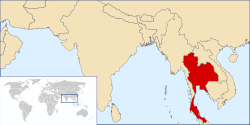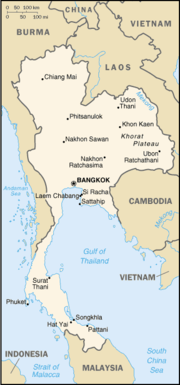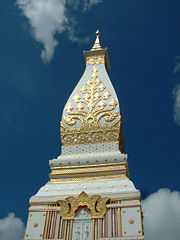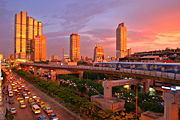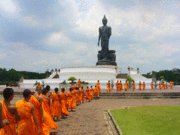Thailand
2008/9 Schools Wikipedia Selection. Related subjects: Asia; Asian Countries
| ราชอาณาจักรไทย Ratcha Anachak Thai Kingdom of Thailand
|
||||||
|---|---|---|---|---|---|---|
|
||||||
| Anthem: Phleng Chat Royal anthem: Phleng Sansoen Phra Barami |
||||||
|
|
||||||
| Largest city | Bangkok | |||||
| Official languages | Thai | |||||
| Demonym | Thai | |||||
| Government | Parliamentary democracy and Constitutional Monarchy | |||||
| - | King | Rama IX | ||||
| - | Prime Minister | Samak Sundaravej | ||||
| Formation | ||||||
| - | Sukhothai Kingdom | 1238–1368 | ||||
| - | Ayutthaya Kingdom | 1350 | ||||
| - | Thonburi Kingdom | 1767 | ||||
| - | Rattanakosin Kingdom | 6 April 1782 | ||||
| - | Constitutional Monarchy | 24 June 1932 | ||||
| Area | ||||||
| - | Total | 513,115 km² ( 49th) 198,115 sq mi |
||||
| - | Water (%) | 0.4 | ||||
| Population | ||||||
| - | December 2006 estimate | 62,828,706 ( 20th) | ||||
| - | 2000 census | 60,606,947 | ||||
| - | Density | 122/km² ( 80th) 317/sq mi |
||||
| GDP ( PPP) | 2006 estimate | |||||
| - | Total | $596.5 billion ( 21st) | ||||
| - | Per capita | $9,200 ( 69th) | ||||
| GDP (nominal) | 2006 estimate | |||||
| - | Total | $206.338 billion ( 34th) | ||||
| - | Per capita | $3,400 ( 92th) | ||||
| Gini (2002) | 42 (medium) | |||||
| HDI (2005) | ▼ 0.781 (medium) ( 78th) | |||||
| Currency | Baht (฿) ( THB) |
|||||
| Time zone | ( UTC+7) | |||||
| Internet TLD | .th | |||||
| Calling code | +66 | |||||
| 1 | ^ Thai name: Krung Thep Maha Nakhon or Krung Thep | |||||
| 2 | ^ According to the Department of Provincial Administration's official register, not taking into account unregistered citizens and immigrants. | |||||
The Kingdom of Thailand (IPA: /ˈtaɪlænd/, Thai: ราชอาณาจักรไทย, IPA: [râːʧa-ʔaːnaːtɕɑ̀k-tʰɑj]) is a country in Southeast Asia. To its east lie Laos and Cambodia; to its south, the Gulf of Thailand and Malaysia; and to its west, the Andaman Sea and Myanmar. Its capital and largest city is Bangkok.
Etymology
The country's official name was Siam ( Thai: สยาม; IPA: [saˈjaːm], RTGS: Sayam origin unknown) until 24 June 1939, and between 1945 and 11 May 1949, when it was changed to Thailand. The word Thai (ไทย) is not, as commonly believed to be, derived from the word Thai (ไท) meaning "freedom" in the Thai language; it is, however, the name of an ethnic group from the central plains (the Thai people). With that in mind the locals seemed to have also accepted the alternative meaning and will verbally state that it means "Land of the free". This might be due to language barriers and the avoidance of long difficult explanations.
Ratcha Anachak Thai means "Kingdom of Thailand" or "Kingdom of Thai". Etymologically, its components are: -Ratcha- (from Sanskrit raja, meaning "king, royal, realm", from Sanskrit) ; -ana- (from Pāli āṇā, "authority, command, power", itself from Sanskrit ājñā, same meaning) -chak (from Sanskrit chakra, meaning "wheel", a symbol of power and rule).
History
The region known today as Thailand has been inhabited by humans since the paleolithic period (about 500,000 - 10,000 years ago). Prior to the fall of the Khmer Empire in the 13th century, various states thrived there, such as the various Tai, Mon, Khmer and Malay kingdoms, as seen through the numerous archaeological sites and artifacts that are scattered throughout the Siamese landscape. Prior to the 12th century however, the first Thai or Siamese state is traditionally considered to be the Buddhist kingdom of Sukhothai, which was founded in 1238, following the decline and fall of the Khmer empire in the 13th - 15th century AD.
A century later, Sukhothai's power was overshadowed by the larger Siamese kingdom of Ayutthaya, established in the mid-14th century.
After Ayutthaya fell in 1767 to the Burmese, Thonburi was the capital of Thailand for a brief period under King Taksin the Great. The current (Rattanakosin) era of Thai history began in 1782 following the establishment of Bangkok as capital of the Chakri dynasty under King Rama I the Great.
European powers began traveling to Thailand in the 16th century. Despite European pressure, Thailand is the only Southeast Asian nation never to have been colonised by a European country. Two main reasons for this were that Thailand had a long succession of very able rulers in the 1800s and that it was able to exploit the rivalry and tension between the French and the British. As a result, the country remained as a buffer state between parts of Southeast Asia that were colonised by the two colonial powers. Despite this, Western influence led to many reforms in the 19th century and major concessions, most notably being the loss of large territory on the east side of the Mekong to the French and the step by step absorption by Britain of the Shan ( Thai Yai) States (now in Myanmar) and the Malay Peninsula. The loss initially included Penang and Tumasik and eventually culminated in the loss of three predominantly ethnic-Malay southern provinces, which later became Malaysia's three northern states, under the ( Anglo-Siamese Treaty of 1909).
In 1932, a bloodless revolution resulted in a new constitutional monarchy. During World War II, Thailand was an ally with Japan while at the same time maintaining an active anti-Japanese resistance movement known as the Seri Thai. After the war, Thailand emerged as an ally of the United States. As with many of the developing nations during the Cold War, Thailand then went through decades of political transgression characterised by coups d'états as one military regime replaced another, but eventually progressed towards a stable prosperity and democracy in the 1980s.
In 1997, Thailand was hit with the Asian financial crisis and the Thai baht for a short time peaked at 56 baht to the U.S. dollar compared to about 25 baht to the dollar before 1997. Since then, the baht has regained most of its strength and as of 23 May 2007, is valued at 33 baht to the US dollar.
The official calendar in Thailand is based on Eastern version of the Buddhist Era, which is 543 years ahead of the Gregorian (western) calendar. For example, the year AD 2008 is called 2551 BE in Thailand.
Politics and government
History
Since the political reform of the absolute monarchy in 1932, Thailand has had 17 constitutions and charters. Throughout this time, the form of government has ranged from military dictatorship to electoral democracy, but all governments have acknowledged a hereditary monarch as the head of state.
1997 to 2006
The 1997 Constitution was the first constitution to be drafted by popularly-elected Constitutional Drafting Assembly, and was popularly called the "People's Constitution".
The 1997 Constitution created a bicameral legislature consisting of a 500-seat House of Representatives (สภาผู้แทนราษฎร, sapha phutan ratsadon) and a 200-seat Senate (วุฒิสภา, wuthisapha). For the first time in Thai history, both houses were directly elected. Many human rights are explicitly acknowledged, and measures were established to increase the stability of elected governments. The House was elected by the first-past-the-post system, where only one candidate with a simple majority could be elected in one constituency. The Senate was elected based on the province system, where one province can return more than one Senator depending on its population size. Members of the House of Representatives served four-year terms, while Senators served six-year terms.
The court system (ศาล, saan) included a constitutional court with jurisdiction over the constitutionality of parliamentary acts, royal decrees, and political matters.
The January 2001 general election, the first elections under the 1997 Constitution, were called the most open, corruption-free election in Thai history. The subsequent government was the first in Thai history to complete a 4-year term. The 2005 election had the highest voter turnout in Thai history and was noted for a marked reduction in vote-buying compared to previous elections.
In early 2006, significant pressure from corruption allegations led Thaksin Shinawatra to call for a snap election. The opposition boycotted the elections and Thaksin was re-elected. Pressure continued to build, leading to a military coup on 19 September 2006.
After the 2006 coup
Without meeting much resistance, a military junta overthrew the elected government of Thaksin Shinawatra on 19 September 2006. The junta abrogated the constitution, dissolved Parliament and the Constitutional Court, detained and later removed several members of the government, declared martial law, and appointed one of the King's Privy Councillors, General Surayud Chulanont, as Prime Minister. The junta later wrote a highly abbreviated interim constitution and appointed a panel to draft a permanent constitution. The junta also appointed a 250-member legislature, called by some critics a "chamber of generals" and others claimed that it lacks representatives from the poor majority. In this interim constitution draft, the head of the junta was allowed to remove the Prime Minister at any time. The legislature was not allowed to hold a vote of confidence against the Cabinet and the public was not allowed to file comments on bills. This interim constitution was later surpassed by the permanent constitution on 24 August 2007.
Martial law was partially revoked in January 2007. The junta continues to censor the media and was accused of several other human rights violations.
The ban on political activities was lifted in July 2007, following the 30 May dissolution of the Thai Rak Thai party. The new constitution has been approved by a referendum on 19 August, which led to a return to democratic elections on 23 December 2007.
Thailand remains an active member of the regional Association of Southeast Asian Nations.
Administrative divisions
Thailand is divided into 75 provinces (จังหวัด, changwat) , which are gathered into 5 groups of provinces by location. There are also 2 special governed districts: the capital Bangkok (Krung Thep Maha Nakhon) and Pattaya, of which Bangkok is at provincial level and thus often counted as a 76th province.
Each province is divided into smaller districts. As of 2006 there are 877 districts (อำเภอ, amphoe) and the 50 districts of Bangkok (เขต, khet). Some parts of the provinces bordering Bangkok are also referred to as Greater Bangkok (ปริมณฑล, pari monthon). These provinces include Nonthaburi, Pathum Thani, Samut Prakan, Nakhon Pathom and Samut Sakhon. The name of each province's capital city (เมือง, mueang) is the same as that of the province: for example, the capital of Chiang Mai province (changwat Chiang Mai) is Mueang Chiang Mai or Chiang Mai. The 75 provinces are as follows:
Central
- Ang Thong
- Bangkok (Krung Thep Maha Nakhon), Special Governed District of
- Chai Nat
- Kanchanaburi
- Lop Buri
- Nakhon Nayok
- Nakhon Pathom
- Nonthaburi
- Pathum Thani
- Phetchaburi
- Phra Nakhon Si Ayutthaya
- Prachuap Khiri Khan
- Ratchaburi
- Samut Prakan
- Samut Sakhon
- Samut Songkhram
- Saraburi
- Sing Buri
- Suphan Buri
East
- Chachoengsao
- Chanthaburi
- Chonburi
- Prachinburi
- Rayong
- Sa Kaeo
- Trat
North
- Chiang Mai
- Chiang Rai
- Kamphaeng Phet
- Lampang
- Lamphun
- Mae Hong Son
- Nakhon Sawan
- Nan
- Phayao
- Phetchabun
- Phichit
- Phitsanulok
- Phrae
- Sukhothai
- Tak
- Uthai Thani
- Uttaradiet
Northeast
- Amnat Charoen
- Buri Ram
- Chaiyaphum
- Kalasin
- Khon Kaen
- Loei
- Maha Sarakham
- Mukdahan
- Nakhon Phanom
- Nakhon Ratchasima
- Nong Bua Lamphu
- Nong Khai
- Roi Et
- Sakon Nakhon
- Si Sa Ket
- Surin
- Ubon Ratchathani
- Udon Thani
- Yasothon
South
- Chumphon
- Krabi
- Nakhon Si Thammarat
- Narathiwat
- Pattani
- Phang Nga
- Phatthalung
- Phuket
- Ranong
- Satun
- Songkhla
- Surat Thani
- Trang
- Yala
NOTE: In italics , that province represents the Greater Bangkok sub-region; in italics , that province represents the West sub-region.
See also: List of cities in Thailand, List of cities in Thailand by population
Geography
At 514,000 km² (198,000 sq mi) , Thailand is the world's 49th-largest country. It is comparable in size to France, and somewhat larger than the US state of California.
Thailand is home to several distinct geographic regions, partly corresponding to the provincial groups. The north of the country is mountainous, with the highest point being Doi Inthanon at 2,565 metres (8,415 ft). The northeast consists of the Khorat Plateau, bordered to the east by the Mekong river. The centre of the country is dominated by the predominantly flat Chao Phraya river valley, which runs into the Gulf of Thailand. The south consists of the narrow Kra Isthmus that widens into the Malay Peninsula.
The local climate is tropical and characterised by monsoons. There is a rainy, warm, and cloudy southwest monsoon from mid-May to September, as well as a dry, cool northeast monsoon from November to mid-March. The southern isthmus is always hot and humid. Major cities beside the capital Bangkok include Nakhon Ratchasima, Khon Kaen, Udon Thani, Ubon Ratchathani, Nakhon Sawan, Chiang Mai, Phitsanulok, Surat Thani, Phuket and Hat Yai.
For maps, see: Atlas of Thailand
Economy
Thailand is a newly industrialised country. After enjoying the world's highest growth rate from 1985 to 1996 - averaging almost 9% annually - increased pressure on Thailand's currency, the baht, in 1997, the year in which the economy contracted by 1.9% led to a crisis that uncovered financial sector weaknesses and forced the government to float the currency. Pegged at 25 to the US dollar from 1978 to 1997, the baht reached its lowest point of 56 to the US dollar in January 1998 and the economy contracted by 10.8% that same year. The collapse prompted a wider Asian financial crisis.
Thailand entered a recovery stage in 1998, expanding 4.2% and 4.4% in 2000, largely due to strong exports - which increased about 20% in 2000. Growth (2.2%) was dampened by a softening of the global economy in 2001, but picked up in the subsequent years due to strong growth in the People's Republic of China, a relatively weak baht encouraging exports and increasing domestic spending as a result of several mega projects and incentives of Prime Minister Thaksin Shinawatra, known as Thaksinomics. Growth in 2002/03 and 2004 was 5-7% annually.
Thailand exports over $105 billion worth of products annually. Major exports include rice, textiles and footwear, fishery products, rubber, jewelry, automobiles, computers and electrical appliances. Thailand is the world’s no.1 exporter of rice, exporting 6.5 million tons of milled rice annually. Rice is the most important crop in the country. Thailand has the highest percent of arable land, 27.25%, of any nation in the Greater Mekong Subregion. About 55% of the available land area is used for rice production.
Substantial industries include electric appliances, components, computer parts and automobiles, while tourism contributes about 5% of the Thai economy's GDP.
Thailand uses the metric system but traditional units of measurement are still much in use. Years are numbered as B.E. (Buddhist Era) on contracts and newspaper datelines; in banking, however, standard Western year counting prevails.
Demographics

Language
Thailand's population can be generally categorized into the Central Thai, the Northeastern Thai or Isan, the Northern Thai, and the Southern Thai. The Central Thai have long dominated the nation politically, economically, and culturally, even though they make up only about one-third of Thailand's population and are slightly outnumbered by the Northeastern Thai. Due to the education system and the forging of a national identity, many people are now able to speak Central Thai as well as their own local dialects.
The largest group of non-Thai people are the Chinese who have historically played a disproportionately significant role in the economy. Many have assimilated into mainstream Thai society, and do not live in Bangkok's Chinatown on Yaowarat Road. Other dominant ethnic groups include Malays in the south, Mon, Khmer and various hill tribes. After the end of the Vietnam War, many Vietnamese refugees settled in Thailand, mainly in the northeastern region.
The Thai language is Thailand's national language, written in its own alphabet, but many ethnic and regional dialects exist as well as areas where people speak predominantly Isan or Mon-Khmer languages. Although English is widely taught in schools, its use is not widespread throughout the country.
Religion
According to the last census (2000) 95% of Thais are Buddhists of the Theravada tradition. Muslims are the second largest religious group in Thailand at 4.6%. Thailand's southernmost provinces - Pattani, Yala, Narathiwat and part of Songkhla Chumphon have dominant Muslim populations, consisting of both ethnic Thai and Malay. Most often Muslims live in separate communities from non-Muslims. The southern tip of Thailand is mostly ethnic Malays. Christians, mainly Catholics, represent 0.75% of the population. A tiny but influential community of Sikhs in Thailand and some Hindus also live in the country's cities, and are heavily engaged in retail commerce. There is also a small Jewish community in Thailand, dating back to the 17th century. Since 2001, Muslim activists, generally described by the Thai government as terrorists or separatists, have rallied against the central government because of alleged corruption and ethnic bias on the part of officials.
Culture

The culture of Thailand incorporates a great deal of influence from India, China, and the rest of southeast Asia. Thailand's main theology Theravada Buddhism is central to modern Thai identity and belief. In practice, Thai Buddhism has evolved over time to include many regional beliefs originating from animism as well as ancestor worship. In areas in the southernmost parts of Thailand, Islam is prevalent. Several different ethnic groups, many of which are marginalized, populate Thailand. Some of these groups overlap into Myanmar, Laos, Cambodia, and Malaysia and have maintained a distinctly traditional way of life despite strong Thai cultural influence. Overseas Chinese also form a significant part of Thai society, particularly in and around Bangkok. Their successful integration into Thai society has allowed for this group to hold positions of economic and political power, the most noteworthy of these being the Thai Prime Minister, Thaksin Shinawatra, who held power from 2001 until 19 September 2006 when he was ousted by a military coup d'état.
Like most Asian cultures, respect towards ancestors is an essential part of Thai spiritual practice. Thais have a strong sense of hospitality and generosity, but also a strong sense of social hierarchy. Seniority is an important concept in Thai culture. Elders have by tradition ruled in family decisions or ceremonies.
The traditional Thai greeting, the wai, is generally offered first by the youngest of the two people meeting, with their hands pressed together, fingertips pointing upwards as the head is bowed to touch their face to the hands, usually coinciding with the spoken word "Sawat-dii khrap" for male speakers, and "Sawat-dii ka" for females. The elder then is to respond afterwards in the same way. Social status and position, such as in government, will also have an influence on who performs the wai first. For example, although one may be considerably older than a provincial governor, when meeting it is usually the visitor who pays respect first. When children leave to go to school, they are taught to wai to their parents to represent their respect for them. They do the same when they come back. The wai is a sign of respect and reverence for another, similar to the namaste greeting of India.
Muay Thai, or Thai boxing, is the national sport in Thailand and its natives martial art call "Muay". In the past "Muay" was taught to Royal soldiers for combat on battlefield if unarmed. After they retired from the army, these soldiers often became Buddhist monks and stayed at the temples. Most of the Thai people's lives are closely tied to Buddhism and temples; they often send their sons to be educated with the monks. ”Muay” is also one of the subjects taught in the temples..
Muay Thai achieved popularity all over the world in the 1990s. Although similar martial arts styles exist in other southeast Asian countries, few enjoy the recognition that Muay Thai has received with its full-contact rules allowing strikes including elbows, throws and knees. Football (soccer), however, has possibly overtaken Muay Thai's position as most widely viewed and liked sport in contemporary Thai society and it is not uncommon to see Thais cheering their favourite English Premier League teams on television and walking around in replica kits. Another widely enjoyed pastime, and once a competitive sport, is kite flying.
Taboos in Thailand include touching someone's head or pointing with the feet, as the head is considered the most sacred and the foot the dirtiest part of the body. Stepping over someone, or over food, is considered insulting. However, Thai culture as in many other Asian cultures, is succumbing to the influence of globalization with some of the traditional taboos slowly fading away with time.
Books and other documents are the most revered of secular objects - therefore one should not slide a book across a table or place it on the floor.
Thai cuisine blends five fundamental tastes: sweet, spicy, sour, bitter and salty. Some common ingredients used in Thai cuisine include garlic, chillies, lime juice, lemon grass, and fish sauce. The staple food in Thailand is rice, particularly jasmine variety rice (also known as Hom Mali rice) which is included in almost every meal. Thailand is the world's largest exporter of rice, and Thais domestically consume over 100 kg of milled rice per person per year. Over 5000 varieties of rice from Thailand are preserved in the rice gene bank of the International Rice Research Institute (IRRI) , based in the Philippines. The King of Thailand is the official patron of IRRI.
Thai society has been influenced in recent years by its widely-available multi-language press and media. There are numerous English, Thai and Chinese newspapers in circulation; most Thai popular magazines use English headlines as a chic glamor factor. Most large businesses in Bangkok operate in English as well as other languages. English is also spoken among many Thais, sometimes as a way of demonstrating their educated, high-society status, but other times because of the lingua franca nature of English. Thailand is the largest newspaper market in South East Asia with an estimated circulation of at least 13 million copies daily in 2003. Even upcountry, out of Bangkok, media flourishes. For example, according to Thailand's Public Relations Department Media Directory 2003-2004, the nineteen provinces of northeast Thailand themselves hosted 116 newspapers in addition to radio, TV and cable.
International rankings
| Organization | Survey | Ranking |
|---|---|---|
| Heritage Foundation | Indices of Economic Freedom | 50 out of 157 |
| Reporters Without Borders | Worldwide Press Freedom Index | 134 out of 169 |
| Transparency International | Corruption Perceptions Index | 84 out of 179 |
| United Nations Development Programme | Human Development Index | 78 out of 177 |


